November 14th 2006 - Chilli burn remedy and my plan to dig up more of the lawn
This is the third year running that weíve grown a chilli variety simply called ĎPurpleí. It isnít really purple, itís almost black and the fruits end up bright red. Who cares - it tastes good and has a pleasant heat. I was collecting seed from them and, as before (how many times?), ended up with chilli burns, so had cause to try out the chilli burn remedy that was sent to me in June. I no longer have the personís email address but did copy out what was said, which was this: ďThe tannins in tea latch on to the same pain receptors as capsicum, and form a stronger bond than the chilli, thereby displacing it and causing the burning sensation to ease.Ē
"This remedy may not work for everyone, but it worked for me and I think itís worth trying"
There was a left over cupful of tea which had been sitting in the pot for a few hours, so I poured it into a bowl and immersed my fingers. The relief was immediate but I kept them in for 20 minutes and then let them dry naturally. As soon as they had dried the burning sensation came back again, but after another five minutes or so it went off and didnít return, leaving only a slight feeling of sensitivity for a day or two.
So, thank you for sending that information, itís been very useful. This remedy may not work for everyone, but it worked for me and I think itís worth trying. Better than having burning fingers for however many days, thatís for sure. Iíd be interested to hear reports, whether it works for you or not.
The urge to dig up more lawn has come on again. For a couple of years now Iíve been nibbling at the edges of whatís left of the lawn and donít think any more can be taken off the edges without it looking silly, so it seems for the best that some of it should simply be removed altogether.
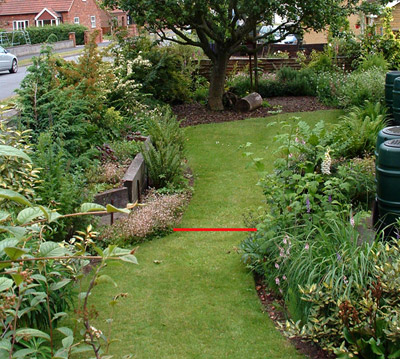
The shady area - all the grass from the red line backwards will go
The bit Iím thinking of is a small area to the north side of the house, from the red line to the fence at the back. From the east it is shaded by the apple tree, from the west we lose the light by about 4pm, even in summer, because of the woods over the road, while the house pretty much shades out any light from the south. At best, that area will get maybe two hours a day of direct sun.
It has always been a trial to keep the lawn there moss and weed free and Iím thinking that it would be better to put in plants that will thrive in those conditions, rather than trying to grow something which doesnít really want to be there. If the moss starts to grow again, as it undoubtedly will, then at least it wonít be all mixed in with the grass.
Doing this will also give us more planting space and increase our options for year round flowers because of all the winter flowering plants that can succeed there. It should look interesting and attractive, as well as complementing the woodland over the road and encouraging more wildlife to visit. We can make a couple of log piles for insect habitats and bury a bucket (with holes drilled in) of bark for beetles to lay their eggs in. The birds will like it and the hedgehogs should be encouraged to come and forage through the new undergrowth.
The lawn under the tree was dug up during winter 2004/5 and planted with Cyclamen coum, Galanthus nivalis and Helleborus x hybridus and H. niger. Itís done well and the plants are spreading Ė the Galanthus and Cyclamen clumps are increasing and the Hellebores are seeding themselves. Iím really pleased with it and have decided that expanding this type of planting is the right and proper solution to a mossy lawn.
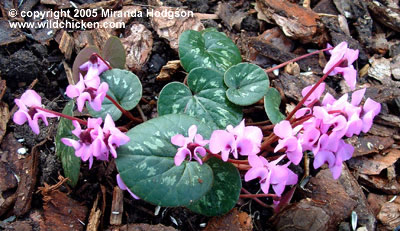
More Cyclamen coum
Many plants are already in place or only need to be moved a few feet, but for others I can divide them from elsewhere or move them from other parts of the garden.
This is the mix I'm currently looking at:
Shrubs:
Berberis darwinii - already there
Berberis x ottawensis - already there
Berberis thunbergii - already there
Cornus sanguinea ĎMidwinter Fireí - to be moved
Cornus stolonifera ĎFlavirameaí - to be moved
Fatsia japonica - to be moved
Hydrangea petiolaris - already there
Hypericum calycinum - already there
Mahonia aquifolium - to be moved
Parthenocissus quinquifolia - already there
Pyracantha 'Orange Glow' - already there
Pyracantha 'Soleil d'Or' - already there
Sarcococca confusa - to be moved
Viburnum farreri - to be moved
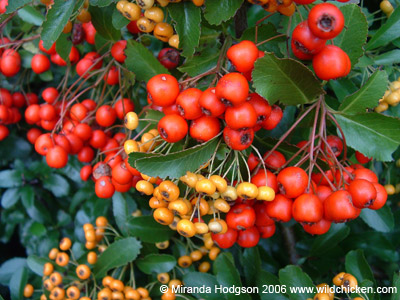
Pyracantha berries - good for attracting birds
Bulbs and perennials:
Aconitum napellus - to be divided and moved
Anemone nemorosa - already there
Aquilegia (various) - already there
Arisaema candidissimum - to be moved
Arum italicum ĎPictumí - need to buy
Astrantia major - already there
Bergenia cordifolia - to be divided and moved
Cyclamen coum - already there
Cyclamen hederifolium - already there
Dicentra spectabilis - already there
Digitalis purpurea - already there
Epimedium pinnatum - to be divided and moved
Various ferns - already there
Galanthus nivalis - already there
Geum rivale - already there
Helleborus niger - already there
Heuchera sanguineum - already there
Liriope muscari - already there
Primula vulgaris - already there
Pulmonaria officinalis - already there
Viola riviniana - already there
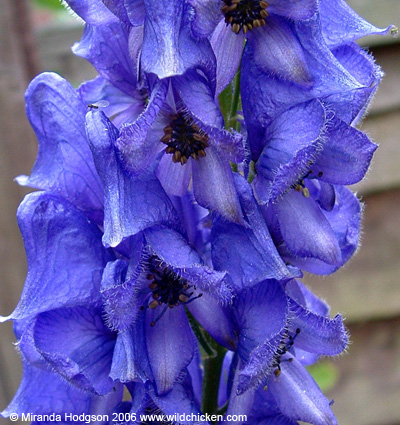
More Aconitum napellus - it attracts bees
Once the lawn is gone, Iíll dig up the ferns and Crocosmia along the side of the house, put in shrubs to grow up and hide the water butts and then put the ferns and Crocosmia back in front of the shrubs. After that Iíll dig leaf mould and compost in to the rest of the area and then find the right spots for the other bulbs and perennials. Some parts of this area get more shade than others so Iíll have to fret over what to put where.
A bark path will meander through the middle and Iíll put a bark and leaf mould covering down around the plants so we can get to them without compressing the soil and making a mess.
There, thatís the plan. A pleasant mix of growing things and then organising them so that it doesnít look too contrived. I canít wait to get started.
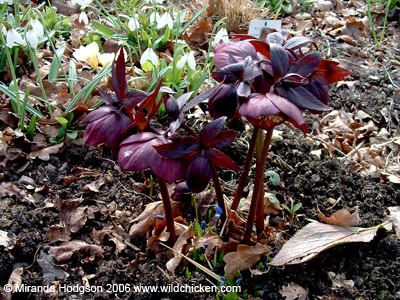
The Helleborus purpurascens that we saw at Beth Chatto's garden would look good in the new set-up.
© Copyright Miranda Hodgson 2006